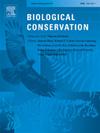这片土地上的水域问题重重:无处不在的威胁和极高的灭绝风险要求采取紧急保护行动,以保护澳大利亚本土淡水鱼类
IF 4.9
1区 环境科学与生态学
Q1 BIODIVERSITY CONSERVATION
引用次数: 0
摘要
我们首次对澳大利亚本土淡水鱼类的灭绝风险进行了全面的全球评估。根据世界自然保护联盟(IUCN)的标准,在241个评估物种中,37%(88个物种)受到威胁(极度濒危、濒危或易危),其中一个物种已经灭绝。Lepidogalaxiidae和Neoceratodontidae受威胁程度最高(100%,均为单一物种科),其次是Galaxiidae(40个物种中的78%)、Percichthyidae(22个物种中的62%)和Melanotaeniidae(19个物种中的53%)。澳大利亚北部的物种更为丰富,而受威胁物种则主要集中在南部和东部排水分区中人口较多的地区,包括西南海岸(55%的物种被评估为受威胁)、塔斯马尼亚(54%)和东南海岸(维多利亚)(45%)。大多数濒危淡水鱼类因其有限的地理范围而被列入名录(标准 B:占所有评估的 70%;标准 D2:7%),但有 21% 的物种评估发现其种群数量减少(标准 A)。物种面临的主要威胁包括入侵物种和其他有问题的本地物种、基因和疾病(占受威胁、接近受威胁或数据不足物种的 92%)、自然系统改变(82%)以及气候变化和恶劣天气(54%)。尽管濒临灭绝的风险很高,但目前针对受威胁物种实施的保护措施非常有限。另有 17 个物种被评估为濒危物种。这项研究凸显了澳大利亚本土淡水鱼类濒临灭绝的现状,并强调急需采取有针对性的保护措施,以避免物种濒临灭绝。本文章由计算机程序翻译,如有差异,请以英文原文为准。
Troubled waters in the land down under: Pervasive threats and high extinction risks demand urgent conservation actions to protect Australia's native freshwater fishes
We conducted the first comprehensive global assessment of the extinction risk of Australia's native freshwater fishes. Using International Union for Conservation of Nature (IUCN) criteria, 37 % (88 species) of the 241 assessed species were threatened (Critically Endangered, Endangered or Vulnerable), with one being Extinct. Lepidogalaxiidae and Neoceratodontidae had the highest level of threat (100 %, both single species families), followed by Galaxiidae (78 % of 40 species), Percichthyidae (62 % of 22 species) and Melanotaeniidae (53 % of 19 species). Northern Australia supported greater species richness, while a concentration of threatened species occurred in the more human-populated areas across southern and eastern drainage divisions, including South West Coast (55 % of species assessed as threatened), Tasmania (54 %) and South East Coast (Victoria) (45 %). Most threatened freshwater fishes qualified for listing based on their restricted geographic ranges (Criterion B: 70 % of all assessments; Criterion D2: 7 %) although population size reduction (Criterion A) was identified in 21 % of species assessments. Key threats to species included invasive and other problematic native species, genes and diseases (92 % of threatened, Near Threatened or Data Deficient species), natural system modifications (82 %), and climate change and severe weather (54 %). Despite the high level of extinction risk, implemented conservation measures for threatened species are presently very limited. A further 17 species were assessed as Near Threatened. This study highlights the imperilled nature of Australian native freshwater fishes and emphasises that targeted conservation measures are urgently needed to avoid imminent extinctions.
求助全文
通过发布文献求助,成功后即可免费获取论文全文。
去求助
来源期刊

Biological Conservation
环境科学-环境科学
CiteScore
10.20
自引率
3.40%
发文量
295
审稿时长
61 days
期刊介绍:
Biological Conservation is an international leading journal in the discipline of conservation biology. The journal publishes articles spanning a diverse range of fields that contribute to the biological, sociological, and economic dimensions of conservation and natural resource management. The primary aim of Biological Conservation is the publication of high-quality papers that advance the science and practice of conservation, or which demonstrate the application of conservation principles for natural resource management and policy. Therefore it will be of interest to a broad international readership.
 求助内容:
求助内容: 应助结果提醒方式:
应助结果提醒方式:


